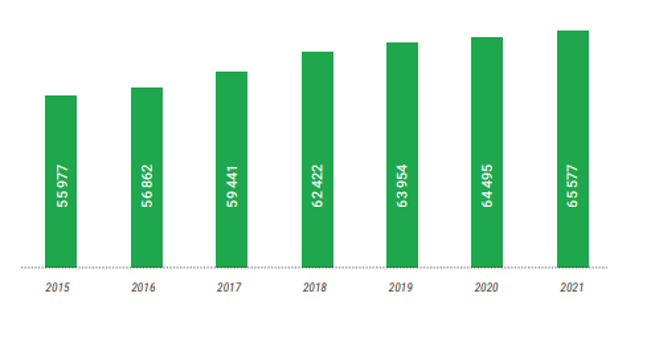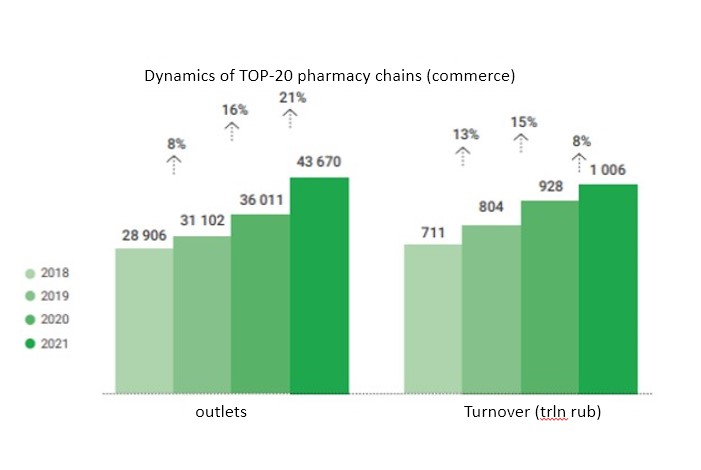Global trends in the development of the pharmaceutical market
Every year, 20-30 new drugs are developed in the world. The average annual growth rate of the global pharmaceutical market is about 6%. The volume of world drug sales is estimated at 2 trillion US dollars. During the COVID-19 pandemic, the pharmaceutical market continued to grow, unlike most other sectors of the economy.
The volume of the pharmaceutical market in Russia in 2021 amounted to 2,295 billion rubles. (excluding vaccines against Covid-19), which is 12.7% higher than the figure for 2020. Drug sales in physical terms amounted to 5.6 billion packs. Covid-19 in 2021 had a noticeable impact on the rating of manufacturers. Even in the top three there was a rotation. Bayer ranked first, followed by Sanofi and Novartis. The maximum growth from the TOP-20 was shown by the domestic companies Biocad, R-Pharm, Pharmasyntez.
As of the end of December 2021, there were 65.6 thousand pharmacies in the country. This is 1.7% higher than a year earlier (+1,080 points).
Rice. 1. Number of pharmacy outlets in Russia

The volume of pharmacy e-com in 2021 amounted to about 126.4 billion rubles. (cumulatively medicinal products and parapharmaceuticals), which corresponds to 8.7% of the pharmacy market capacity.
Fig.2. Pharmacy e-com dynamics, 2019-2021

In general, the capacity of the pharmacy market in 2021 amounted to 1,456 billion rubles. (+3.5% compared to the previous year) .
In 2021, the TOP-20 unites 43.7 thousand pharmacies, which is 21% more than in 2020. In the 2021 ranking, 11 networks have more than 1,000 outlets in their quantitative composition, and all of them are from 1 to 11 places.
Fig.3. Growth dynamics of turnover and number of points of TOP-20 pharmacy chains

Thus, the pharmaceutical market in Russia has a high potential for growth, but at the same time is highly competitive. Why should people choose one pharmacy over another? Is it always only the price that influences the choice of the place of purchase, or are there other factors as well.
For a long time, marketers around the world have identified a whole list of techniques that can increase sales of over-the-counter drugs in a pharmacy, one of which is merchandising.
What is merchandising in a pharmacy and how does it affect sales growth?
Pharmacy merchandising means creating an environment that makes the customer want to buy a specific product (drug, cosmetic product, etc.). Essentially, this means that the product must be visible to the customer and accessible, while the space itself must create a positive shopping experience. experience for a pharmacy client.
The main goal of merchandising in a pharmacy is
to attract the right customer by creating the right image of the pharmacy. And the second goal - after you have attracted the buyer to you, you must
inspire him to buy.
Exactly the same goals are pursued by sellers of any other goods, be it food, household appliances or clothing. But often, it is in pharmaceuticals that the role of merchandising is underestimated.
One of the features of merchandising in pharma is building a constructive interaction between the merchandiser and employees of the outlet in order to adjust the layout in accordance with the existing agreements between the client and the outlet, which are often violated in practice.
According to experts, 75% of all purchases are made on the occasion of emotions. In addition, people buy where it is easier and more convenient to do so.
With regard to pharmacy products directly, according to statistics, the decision in favor of a particular drug in 10% of cases is made on the basis of a doctor's prescription, in 20% of cases - on the basis of the experience of the buyer himself (and merchandising influences him) and in 70% - based on the recommendation of the pharmacist, because most buyers come to the pharmacy, including for advice. The result of the merchandiser's work to build interaction with the seller and increase his brand loyalty also influences which drug the pharmacist will recommend. Moreover, a large number of purchases in the pharmacy are made unplanned. And merchandising has a direct impact on the purchase decision process, making the product more visible and stimulating the buyer's interest in it.
But how exactly to make the product more visible? How to improve its layout?
Various
merchandising techniques are used for this.
1) The number of units of goods of a certain brand or group (faces) on the shelf. The facing rule states that one product name must be presented in a pharmacy in several units. Face - in translation from English "face", and in the language of marketing - packaging, where the brand is declared. The more “faces” of a particular brand surround the buyer, the higher the chance that he will reach out for the package. Experts recommend laying out more than three packages of the product during the period of its seasonal use, during an advertising campaign in the media, or during the actions of the pharmacy itself. With the help of facing, the buyer creates a feeling of fullness and plurality of choice. This feeling leads to an increase in turnover.
2) Distribution of goods on the shelves
¬Small items should be placed at the top, larger and heavier items at the bottom.
¬Avoid extra space and obvious gaps between items.
¬Display product face out for style and ease of viewing and selection.
¬Be proud of your best product, show it in the best place in the pharmacy, where the buyer can quickly find it.
¬In the zone of the greatest concentration of human attention are objects located at eye level, more precisely, in the zone of ± 20 cm from the eye level of an adult of average height, which usually means the second and third shelves from the top with a standard five to six shelf rack. Items placed at eye level sell much better than other shelves. When placing products that are designed for children, you need to take into account the level of the child's eyes.
¬Dead zone rule. Everything that a stationary person sees around him is called the visual field. Objects that fall into the lower part of the visual field are often left without attention. At the same time, the lower left corner is the most unfortunate - there the person’s gaze stops the least. Accordingly, the lower shelves, as the least inspected, should be occupied by large packages (for example, baby diapers) or product stock. At the same time, it is important to take into account certain restrictions on the storage of drugs associated with photosensitivity or temperature requirements.
¬Place related products next to each other for impulse buying. For example, shower gel and washcloth, floss and breath freshener, etc.
3) Checkout area This area is often referred to as "hot". It is especially profitable. 2-3 products should be sold only at the checkout. Carefully select the goods for sale in this area and do not clutter it.
4) Adaptation zone The zone from the entrance to the middle of the hall is called the adaptation zone. Here it is recommended to lay out only goods that are well known to customers, since at the entrance to the pharmacy the concentration of attention is too low to be able to consider new products, analyze the offer and make a choice.
5) Correct and visible price tags The average buyer will not buy a product if he has no idea about its price.
¬The price of the product should be clearly marked and clearly visible to the buyer, the price tag should not cover the packaging of the drug or product.
¬Price tags should be arranged so that it is extremely clear to the buyer which price tag refers to which product.
¬The location of price tags should take into account the angle of view of the buyer.
¬All price tags in the pharmacy must be designed in the same style, it is allowed to change the background and some details to draw attention to certain drugs or products.
There are many more aspects in the implementation of successful merchandising in a pharmacy, taking into account the presence of open or closed display cases, prescription drugs, medicines that require special storage conditions. Merchandising experts of the OPEN Group agency offer a variety of service options depending on the needs of the business (audit of the brand presence in the pharmacy, merchandising, detailing), and also offer manufacturers the most effective tools to increase sales.

Evgeniy Kretov, account manager, explains how pharmacy merchandising differs from grocery merchandising and what are the features of the OPEN approach.
- We use an individual approach to each client, depending on the technical conditions, geography of coverage, project goals and business needs. The level of employees in pharmacy-oriented projects is always higher than in FMCG projects, since work in a pharmacy always involves communication with a pharmacist, so the communication skills and competence level of a merchandiser correspond to the position of a sales representative. An important role is played by continuous training of employees, since not only a good knowledge of the range is one of the key skills of employees, but also the composition of products, contraindications, applications, and competitive advantages. The peculiarities of his work are that every day the employee solves various tasks, this is not a repetitive routine every day. This job is suitable for active people,
Based on the experience of implementing projects in OPEN, the following components of success in pharmacy merchandising can be distinguished:
1) Careful selection of personnel, taking into account that candidates have good communication skills, basic knowledge and experience in medicine.
2) Training employees in the basics of merchandising, shelf design standards, business ethics and communication, and, importantly, basic marketing approaches, so that specialists understand how and due to what the manufacturer becomes No. 1 on the shelf.
3) Motivation and encouragement of employees for the initiative, the proposal of new ideas, each of which is considered and has every chance of being implemented.
4) Conducting regular team meetings aimed at sharing experience and studying the best practices in working with pharmacies in Russia and the world, analyzing analytics on projects, sales and the market situation.
5) Continuous development, adaptation and improvement of services and approaches to project implementation in accordance with market trends.
6) One of the most important conditions for the performance of quality work is the transfer of knowledge from the primary source (customer) to the contractor (agency) through joint visits to outlets and corrective feedback.
7) A high-quality SFA-system through which the control of the implementation of the tasks set is implemented.
8) High Span of control - no more than 10 merchandisers per supervisor, while the average level in FMCG is 14 merchandisers per 1 supervisor. This is due to the greater geographical coverage for the supervisor (typically for pharmacy merchandising), which affects both the management model of the field team and the effectiveness of its training.



 Evgeniy Kretov, account manager, explains how pharmacy merchandising differs from grocery merchandising and what are the features of the OPEN approach.
Evgeniy Kretov, account manager, explains how pharmacy merchandising differs from grocery merchandising and what are the features of the OPEN approach.